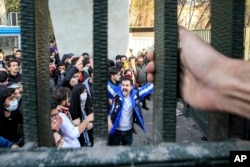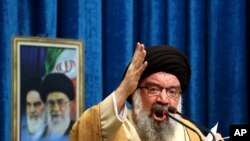Having survived popular protests across major cities in Iran, Iranian leaders are now turning to the tools that helped protesters organize and coordinate large-scale demonstrations against the government, which continued for more than a week before the government suppressed them.
A senior Iranian official this week urged the country’s cyberspace authorities to remain vigilant and prevent another potential wave of protests.
On the sidelines of a technical summit in the capital Tehran, where high-ranking officials gathered to discuss the country’s technological challenges, General Gholamreza Jalali expressed concerns over the possibility of yet another round of popular protests aided by social media and the internet.
Jalali is head of Iran’s Civil Defense Organization.
In December 2017, tens of thousands of Iranians took to the streets to protest, among other things, the country’s economic policies and the government’s inability to provide economic opportunities for its citizens. Protesters were also demanding more civil liberties.
The country’s Supreme Leader, Ayatollah Ali Khamenei, met with cyberspace experts to brainstorm ideas to address what they saw as the challenges and threats that the internet and social media platforms pose to the leadership of the Islamic Republic.
Ayatollah Ahmad Jannati, head of the powerful Guardians Council, told Tasnim news agency, a hard-line media outlet with ties to the Islamic Revolutionary Guards Corps (IRGC), that Khamenei ordered the meeting to take place.
‘It will bite again’
Jannati, who did not give details of the meeting, said the government must have full control over the internet.
“I’m not saying it [internet] has to be fully blocked,” Jannati reportedly said. “That’s impossible. But we have to reduce [control] it.”
Iranian leaders and their supporters voiced what it sees as the threats posed by people’s access to the internet.
“Cyberspace as a platform for foreigners is a mad dog,” Ayatollah Ahmad Khatami, a hard-line cleric and interim sermon to Tehran’s Friday prayer said last month.
“If left alone, it will bite again,” Khatami added.
Some analysts believe the recent rhetoric against the internet could mean more restrictions.
“The recent quotes we hear these days implies that authorities are preparing grounds for a new round of social media ban in Iran,” a Tehran-based media analyst, who spoke to VOA on condition of anonymity, said.
“It seems that the Iranian supreme leader wants more control over social media platforms, and no one dares to oppose him on that subject,” the analyst added.
Government blocking
Iranian authorities regularly block news websites and social media platforms in addition to blocking foreign television and radio broadcasts to the country.
In an effort to control the flow of communication, the government steers local IP addresses to a domestic internet dubbed National Data Network, where it monitors people’s communication exchanges.
To avoid government surveillance, some users have found ways to bypass blocks put in place by authorities.
Now government officials are signaling they might target encrypted messaging platforms.
“Hard-liners are targeting social media that can be used as an untraceable means of communication,” Mohammad Ali Khorassani, a U.K.-based social media analyst, said.
“These new forms of media are harder to track down and easier to convey encrypted mass messages and (are) very suitable for promoting campaigns,” Khorassani added.
In some cases, when a government cannot monitor some communication platforms, the other solution is complete blockage.
As the protests gained momentum last December, the government blocked Telegram and Instagram in parts of the country. The two social media applications are widely used across the country.
The block stayed in place for several days until the protests waned. President Hassan Rouhani, who to some extent owes his victory of last year’s presidential election to these social media platforms, ordered the restoration of the services.
Telegram: A nightmare
For those in charge of monitoring the internet in Iran, the encrypted Telegram application is a constant headache and a nightmare.
“It’s not acceptable for people to use a monopolized social media,” Mahmoud Vaezi, Rouhani’s chief of staff, told reporters January 17, referring to only Telegram.
According to Pavel Durov, the Russian CEO and co-founder of Telegram, the messaging application has an estimated 40 million active users in Iran. Iranian officials, however say the popular social messaging tool has 30 million users, which is still a considerable number of the country’s nearly 80 million population.
“The servers of any social media website or application that has more than 30 million Iranian members should not be outside the country,” Jalali, the head of Iran’s Civil Defense Organization, said in 2017.
“This is a national security necessity and not a political one,” Jalali claimed.
Telegram’s imminent blockage
Iranian authorities reportedly requested Durov to transfer its servers to Iran. When the company declined, prosecutors in Tehran filed a case against the company, alleging that the application provided terror groups like the Islamic State a platform for communication.
U.K.-based social media analyst Mohammad Ali Khorassani said it is just a matter of time before the government blocks Telegram.
The “Telegram app, which is the most used app among Iranians, is the No. 1 target of this new blockage,” Khorassani said.
The government is also pushing alternative applications, developed by Iranians, in an effort to discourage people from using the encrypted Telegram.
Last month, the official account of Iran’s Supreme Leader on Telegram announced the launch of an account for iGap and Soroush, which are applications similar to Telegram in function but that are controlled by the government.
In its latest report, the London-based Small Media Foundation, which monitors violations of the free flow of information, interpreted the move as a possible sign of a coming ban on Telegram in Iran.
















